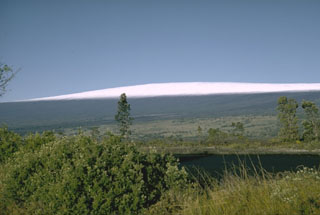Report on Mauna Loa (United States) — 26 June-2 July 2019
Smithsonian Institution / US Geological Survey
Weekly Volcanic Activity Report, 26 June-2 July 2019
Managing Editor: Sally Sennert.
Please cite this report as:
Global Volcanism Program, 2019. Report on Mauna Loa (United States) (Sennert, S, ed.). Weekly Volcanic Activity Report, 26 June-2 July 2019. Smithsonian Institution and US Geological Survey.
Mauna Loa
United States
19.475°N, 155.608°W; summit elev. 4170 m
All times are local (unless otherwise noted)
HVO reported that during the previous several months earthquake and ground deformation rates at Mauna Loa were elevated above background levels. During the first half of 2018 the seismic network recorded fewer than 20 shallow, small-magnitude earthquakes per week. Following a significant earthquake swarm in October, the rate increased to at least 50 events per week beneath the summit, upper Southwest Rift Zone, and upper west flank. These locations were similar to those that preceded eruptions in 1975 and 1984. GPS and satellite RADAR data detected deformation consistent with recharge of the shallow magma storage system. The increased seismicity and deformation indicated that Mauna Loa is no longer at background levels, prompting HVO to raise the Aviation Color Code to Yellow and the Volcano Alert Level to Advisory. HVO noted that an eruption was not imminent.
Geological Summary. Massive Mauna Loa is a basaltic shield volcano that rises almost 9 km from the ocean floor to form the world's largest Holocene volcano. Flank eruptions typically occur from the lengthy NE and SW rift zones, and from the Moku'aweoweo summit is caldera, which is within an older and larger 6 x 8 km caldera. Two of the youngest large debris avalanches documented in Hawaii traveled nearly 100 km from Mauna Loa; the second of the Alika avalanches was emplaced about 105,000 years ago (Moore et al., 1989). Almost 90% of the surface of the volcano is covered by lavas less than 4,000 years old (Lockwood and Lipman, 1987). Beginning about 1,500 years ago, a series of voluminous overflows from a summit lava lake covered about 25% of the volcano's surface. Over the last 750 years, from shortly after the formation of Moku'aweoweo caldera until the present, an additional 25% of the volcano has been covered with lava flows, mainly from summit and NW rift zone vents.
Source: US Geological Survey Hawaiian Volcano Observatory (HVO)

